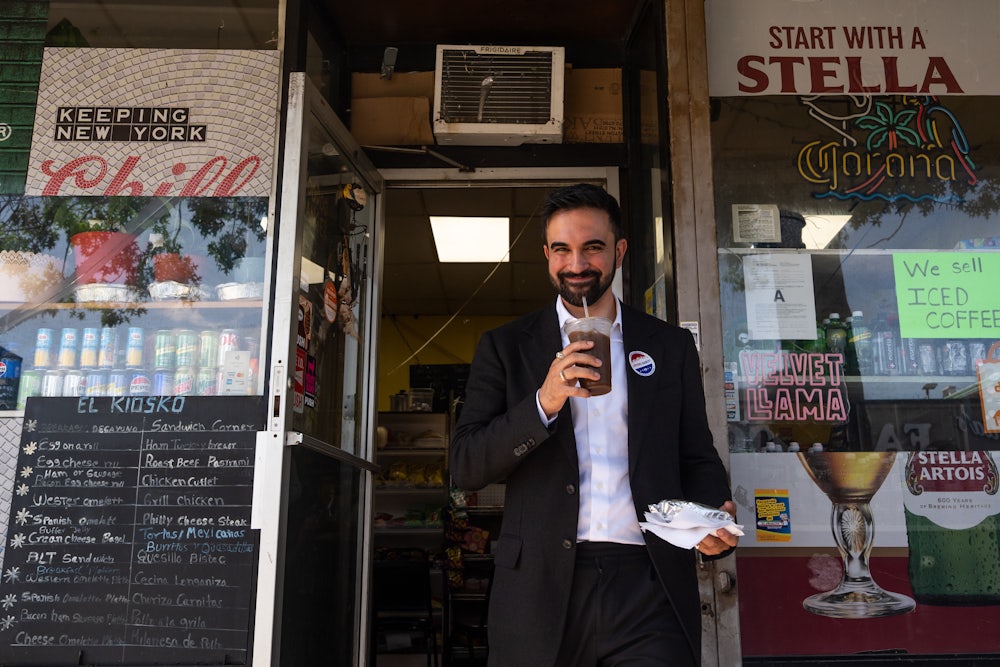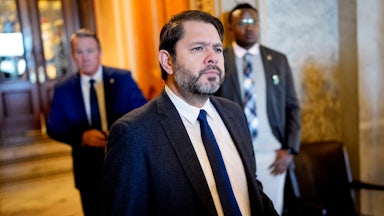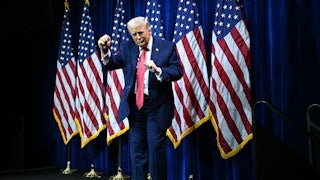Zak Khan wasn’t always the Gyro King of Brooklyn. He started out with a little halal cart down on Wall Street, in the Financial District, just after the September 11 attacks. But running a halal cart is a rough business: Permits cost an arm and a leg, the city fines you without mercy, and in the end it was actually cheaper for him to open a brick-and-mortar restaurant. He expanded steadily, and today his gyro kingdom spans the steppes of Central Brooklyn, from Midwood and Bay Ridge to Coney Island Avenue’s Little Pakistan.
During the coronavirus pandemic, Khan started giving out hot halal meals. One of the people who showed up to help was a young state assembly member who wasn’t even from the district: Zohran Mamdani. So when Mamdani announced his campaign for mayor last October, Khan made the pilgrimage to Long Island City in Queens for the launch. He still remembers Mamdani’s exact words: “This is not a time for lecturing. It’s a time for listening.”
The moment Mamdani won the Democratic primary for New York City mayor, the political consultant and pundit classes started trying to distill the precise chemical formula of his appeal. How did Mamdani, a member of the Democratic Socialists of America, demolish former Governor Andrew Cuomo, electrify the normally sleepy off-year electorate, and upend the traditional calculus of money = votes? Was it the short-form videos? The visual branding? The rizz? The clothes? The “attentional strategy”?
Full disclosure: I door-knocked for Mamdani’s campaign on two occasions, plus a short, sweltering stint outside the polls on Election Day. I’d never volunteered on a political campaign in my life—I’m a journalist, not a joiner of political parties—but I could see that Mamdani was a different kind of politician, and I wanted to see it from the inside. And here’s what I concluded: Mamdani understood something that all the professional moonbeam extractors missed. You don’t appeal to working- and middle-class voters by going on all the right podcasts, hiring influencers like Olivia Julianna, posting on social media a certain number of times per day, or hammering at them with meticulously focus-grouped talking points. Mamdani’s secret sauce is much simpler.
The trick to messaging working- and middle-class voters is that you don’t. You stop fretting about what you’re telling them, and how, and on what precise algorithmic formula of platforms and formats. You shut up and start listening to what they’re telling you. You listen to what they care about. And then you talk about that. Nowhere is that strategy clearer than in the way Mamdani used the most powerful form of political propaganda: food.
Food has been the key to electoral politics since the days of bread and circus. But for modern-day Dems—and their consultants, surrogates, and attendant media—this is apparently news. Think of the Democrats lecturing us that food prices didn’t matter because of the offsetting benefits of Bidenomics. When they do try to use food, it’s even worse. Remember Biden holding an ice cream cone as though it was a live grenade and musing awkwardly about Gaza? Or Nancy Pelosi showing us her two enormous brushed-steel refrigerators, stuffed with $12-a-pint boutique ice cream, at a moment when a lot of Americans were wondering how to get their next meal?
Mamdani used food as a touchstone in a way that felt organic and joyful instead of pandering and forced. His campaign logo’s hand-drawn letters, with their contrasting drop shadows, echoed the hand-painted bodega awnings that beckon New Yorkers as they walk home hungry, drunk, or high (or all three). The posters’ typographic design also referenced old grocery store price posters, the kind they used to paint by hand whenever something went on sale (subliminal message: cheap food!). The campaign’s borough-specific signage also resembled the Seamless ads that have dominated the subways for the past two decades, striking two powerful subconscious chords in every New Yorker’s heart: food and subways. In a world drowning in AI slop, the handcrafted lettering felt human and homey.
Even the logo’s colors were delicious: Red and yellow are the top two colors in food logos and branding (Cheerios, mustard, McDonalds) because they increase memory, attention, and alertness; marketers think they influence food sales by stimulating your appetite—especially in combination with each other, a belief called the ketchup-and-mustard theory of color psychology.
But this went deeper than branding. Mamdani made food a key part of his platform, which centers on making New York affordable. One of his signature proposals is a pilot program of five city-owned grocery stores, one in each borough. He also wants to create a mom and pop czar who would help small businesses like delis and bodegas navigate permits and financial assistance. He laid out this plan in a video recorded—where else?—inside a bodega, where he ordered the staple breakfast of New York City: egg and cheese on a roll (his with jalapeño instead of bacon). And he devoted an entire video to halalflation: the skyrocketing price of a standard chicken over rice, the halal cart meal that’s essential to everyday working life in New York. Pizza and bagels are great, especially if you’re a tourist who wants to stand in line, but a lot of working-class New York runs on halal chicken and rice.
Mamdani did something simple but revolutionary: He asked halal cart owners why they raised the price of chicken and rice from $8 to $10. The city’s licensing process leads to an owner monopoly on halal cart licenses—a problem he knows well, because he went on a hunger strike in 2022 to support taxi drivers who were suffering under a similar monopoly on taxi medallions. And then he named four City Council bills that could solve this problem. “If I was the mayor, I’d be working with the City Council from day one,” he said, with his trademark dimpled smile, “to make halal eight bucks again.”
None of this feels gimmicky or poll-tested. I think the guy genuinely loves food. When he was a kid in South Africa, and a teacher asked if he was white, black, or “coloured”—the official term for multiracial under apartheid, still used informally—he described himself as “mustard.” Later, as the rapper Mister Cardamom, he recorded “Nani,” a paean to his maternal grandmother; the music video stars Madhur Jaffrey, the beloved cookbook author. At the end of “Nani,” he dances inside a halal cart, shirtless and holding a sandwich—to the consternation of right-wing haters, who apparently hate to see people enjoying food (especially what they would no doubt call “ethnic” food). MAGA influencers also lost their minds over a clip of him eating biryani rice with his hands while discussing Third World solidarity with Palestinians. This is an extremely normal way to eat in rice-eating countries, from North Africa to the Middle East and all parts of Asia. But it triggered an avalanche of racist commentary from the likes of Laura “I just ate dog food” Loomer.
But no matter how much Mamdani clearly loves food, I don’t think his emphasis on it is unconscious or merely instinctive. It taps into a deep tradition within American socialism of addressing justice through practical, bread-and-butter issues. Milwaukee had its sewer socialists, who excelled at delivering basic services. Mamdani is proposing what I’m going to call halal cart socialism: using the lesser-known mechanisms of city government to improve the delivery of basic goods—especially the ones, like food and childcare, that mean survival in everyday people’s lives.
A month ago, on a hot Friday evening, I joined hundreds of other nerds for a conversation between Mamdani and two leading lights of the anti-monopoly movement: Zephyr Teachout, a law professor who ran for governor of New York State against Cuomo in 2014, and Lina Khan, a law professor and former chair of the Federal Trade Commission under Biden.
All three talked about small businesses—groceries, pharmacies, barbershops—and how New York City’s government can be a powerful tool to strengthen them: not just by cutting the kinds of fines and fees that hamper businesses small and big (the Abundance school, which has been flirting with Mamdani) but also by taking on monopolies (the Joe Biden–Lina Khan school). “New York City being the most expensive city on earth isn’t inevitable,” said Mamdani. “It’s a choice.” The same landlords who said they couldn’t afford a rent freeze, he pointed out, had just donated $2.5 million to Andrew Cuomo’s campaign.
I wanted to know more about Mamdani’s pilot program to open five city-owned groceries, one in each borough: How will it work? Will it bring down prices? By offering food at cheaper prices, will it hurt other businesses, as John Catsimatidis, the billionaire grocery mogul and sometime political candidate, is warning? So I asked Teachout if she would meet me at a grocery store and tell me more.
We met, at her suggestion, in the air-conditioned lobby of the Whole Foods on 125th Street in Harlem. “We have fewer Black-owned grocery stores today than we did in 1965,” she said, by way of introduction, before veering down the escalator into the bowels of the megastore. Teachout believes that Mamdani’s city-owned grocery stores can do more than just offer food at lower prices. She’s hoping they can be a wedge to take on the monopolies that make those prices higher in the first place—and thereby help local mom-and-pop stores.
“You can’t sell cereal to Whole Foods at a cheaper price than to an independent grocer, unless there’s a real cost reason,” she said, pointing to a box of Cheerios: $7.19 for a family size. “But what happens is these behemoths, like Whole Foods, can demand a better deal, and then can undercut competitors—not because they’re more efficient, not because they’re serving anybody any better. And that destroys the base of local grocery stores.”
To illustrate this point, she walked us uptown to Pioneer, an independent supermarket chain a few blocks away. “We have two sets of laws in the grocery business,” she said. “Little grocery stores have to strictly follow price-gouging laws. And Tyson, and Procter & Gamble, the big meatpackers—the dominant upstream firms—don’t have to follow the rules.” In the cereal aisle, she picked out the same box of Cheerios: $10.79.
Teachout thinks Mamdani won a lot of trust with voters by simply acknowledging something they care about: that the prices they’re paying are unnaturally high, for reasons that aren’t necessarily linked to underlying costs. Customers might not know the details of the Robinson-Patman Act, a federal law prohibiting suppliers from selling to different grocery stores at different prices, but they know when they’re being had.
“Whether it’s price-fixing in eggs, or price-gouging in diapers, they know that these prices are not fair, and they do not reflect real costs,” she said. “And so he’s not just saying, ‘I’ll do a pilot program.’ He’s saying, ‘I actually see this pricing problem.’ I think that’s really, really powerful. And what that leads to, when you have a Mayor Mamdani, is an administration that is asking questions about shady practices that we have just accepted as ‘that’s part of capitalism.’”
If you’re the Gyro King of Brooklyn, there’s only one way to celebrate the triumph of Zohran Mamdani: by giving away 500 free meals at the Parkside and Ocean Avenue entrance to Prospect Park on the Friday after the primary. “It’s not for Zohran,” said Khan, as an army of helpers unloaded giant steaming vats of—what else?—halal chicken and rice. “It’s for the people.”
I got in line with hundreds of other New Yorkers, including Sai Foster, 22. They didn’t vote because they just moved here from California, but they showed me a picture on their phone: an election flyer from Morris Hillquit, a socialist who ran for mayor of New York in 1917.
“It is the duty of the city to get decent food to the people at decent prices,” Hillquit said in the flyer, denouncing “high rents, high prices, 10-cent bread, 14-cent milk, hungry school children, and a high death rate among the babies of the poor.” He promised to buy milk directly from farmers and put the milk profiteers out of business.
“What will be interesting,” said Foster, “is to see if Mamdani can maintain his policies once he’s in office. Especially when things get difficult.”
It’s a colossal “if,” no doubt. To begin with, Mamdani needs to dispatch Mayor Eric Adams and Cuomo (again) in November’s general election. Then, to deliver on his agenda, he will have to take on forces over which he has very little control. Billionaires poured at least $25 million into Fix the City, the super PAC backing Andrew Cuomo, in an attempt to torpedo his primary campaign. They’re sure to pour even more into defeating him in the general; or, perhaps worse, into stonewalling or co-opting him should he take office. The governor and state legislators in Albany won’t necessarily make things easy, either.
But Mamdani has something very powerful on his side, too: the people. He succeeded because he listened to New Yorkers’ deepest fears and anxieties about surviving day-to-day in the city, and then he made those worries central to his campaign; that is, his message resonated with voters because it was their message. And equally important, he showed voters exactly how he would use the mechanisms of government to address their concerns.
I think that’s why Mamdani’s campaign focused so heavily on food: It’s inseparable from survival as well as dignity, a duality summed up in the old labor slogan that the Democratic Socialists of America’s logo is based on: “We want bread, and roses too.”
In his victory speech, Mamdani quoted Franklin Delano Roosevelt on a struggle that many Americans are feeling as keenly right now as they did in 1938. “Democracy has disappeared in several other great nations—not because the people of those nations disliked democracy,” FDR said in a fireside chat, “but because they had grown tired of unemployment and insecurity, of seeing their children hungry while they sat helpless in the face of government confusion and government weakness through lack of leadership in government. Finally, in desperation, they chose to sacrifice liberty in the hope of getting something to eat.”
Mamdani rejected that as a false choice. “New York, if we have made one thing clear over these past months, it is that we need not choose between the two,” he said in his speech. “We can be free. And we can be fed.”






